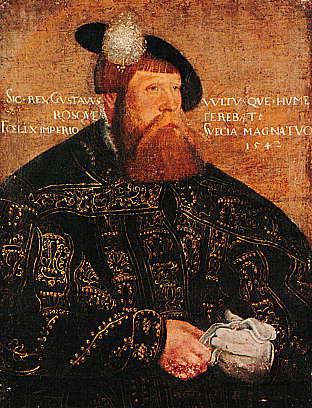
 Sweden 5 Kronor 1978 VG
Sweden 5 Kronor 1978 VGFront: King Gustav Vasa (1523-1560);
Back: Stylised crowing wood-grouse and a spruce
Gustav I portraited in 1542 by Jakob Bincks
 Gustav I, born Gustav Eriksson (Colloquial 15th century Upplandic, Gösta Jerksson) and later known as Gustav Vasa (12 May 1496 – 29 September 1560), was King of Sweden from 1523 until his death. He was the first monarch of the House of Vasa, an influential noble family which came to be the royal house of Sweden for much of the 16th and 17th centuries. Gustav I was elected regent in 1521 after leading a rebellion against Christian II of Denmark, the leader of the Kalmar Union who controlled most of Sweden at the time.
Gustav I, born Gustav Eriksson (Colloquial 15th century Upplandic, Gösta Jerksson) and later known as Gustav Vasa (12 May 1496 – 29 September 1560), was King of Sweden from 1523 until his death. He was the first monarch of the House of Vasa, an influential noble family which came to be the royal house of Sweden for much of the 16th and 17th centuries. Gustav I was elected regent in 1521 after leading a rebellion against Christian II of Denmark, the leader of the Kalmar Union who controlled most of Sweden at the time.Gustav was an enigmatic person who has been referred to as both a liberator of the country and as a tyrannical ruler, which has made him the subject of many books. When he came to power in 1523, he was largely unknown, and he became the ruler of a still divided country without a central government. Though not as famous as most of his continental contemporaries, he became the first truly autocratic native Swedish sovereign and was a skilled propagandist and bureaucrat who laid the foundations for a more efficient centralized government. During his reign Protestantism was introduced in the country.
In traditional Swedish history he has been labelled the founder of modern Sweden, and the "father of the nation". Gustav liked to compare himself to Moses, whom he believed to have also liberated his people and established a state. As a person, Gustav was known for ruthless methods and a bad temperament, but he also loved music, and had a certain sly wit. In the late 1550s, Gustav's health declined. When his grave was opened in 1945, an examination of his corpse revealed that he had suffered chronic infections of a leg and in his jaw.
He gave a so-called "last speech" in 1560 to the chancellors, his children and other noblemen, whereby he encouraged them to remain united. On 29 September 1560, Gustav died and was buried (together with two of his wives) in the Cathedral of Uppsala.
The tomb of Gustav Vasa in Uppsala domkyrka

Information and Image Obtained From Wikipedia, the free encyclopedia
No comments:
Post a Comment